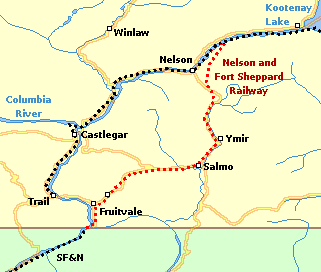Columbia and Western Railway

The Columbia and Western Railway was a historic Canadian narrow gauge railway located in southern British Columbia.
Constructed in 1896, its route connected silver and gold mines at Red Mountain and Rossland and a smelter at Trail. Augustus Heinze was the force behind the line as he also was the developer behind the Trail smelter and worked quickly to gain competitive advantage prior to the construction of the Canadian Pacific Railway into the Kootenay region.
Premier Turner of Victoria passed "An Act to Incorporate the Columbia and Western Railway Company" (C&W) on April 17, 1896. Capitalization was stated to be $5 million. Besides bestowing a grant of 10,240 acres (4,140 ha) of land per completed mile of the narrow-gauge trackage—20,000 acres (8,100 ha) for any standard gauge built—the Act permitted the C&W to build west through the metal-rich Boundary District and on to Lake Okanagan at Penticton to connect with the CPR's lakeboat service to its Mainline via that lake to the Shuswap and Okanagan Railway. The company had four years to accomplish the construction or lose the $50,000 deposit that it was required to remit to the government within six months of the Act's passage.
Initially it was a 3 ft (914 mm) narrow gauge line, and the steep, 3,400-foot (1,036 m) rise up the mountain from the Columbia River necessitated the use of three Shay locomotives to move the open ore cars, past the fruit trees of Warfield, and onto the LeRoi and War Eagle mines. A spur ran to the Arrow Lakes steamer landing at Robson. Heinze sold to Canadian Pacific Railway in 1898. The line was regauged to 4 ft 8 1⁄2 in (1,435 mm) standard gauge by the CPR in 1899.
The CPR had a standard gauge portage railway running from Nelson to Robson and it was built in 1891. The CPR then embarked on a massive expansion placing a line over the Crowsnest Pass to Creston, which indirectly connected to Nelson, then to the portage railway down the Kootenay River. The fundamental basis for all of this was to move coal from Fernie to the smelter at Trail—in connection with shifting the ore down Red Mountain and sending the final reduced concentrates out to the Eastern US. The purchase of the C and W line allowed for the continued westward expansion of a standard gauge line. This it did by 1900 running a link via Brooklyn, Gladstone and Paulson to Grand Forks.
The CPR took the C and W and its generous land grants and merged it into the Kettle Valley Railway it was then building. Technically, the portion of the Kettle Valley Line that runs from West Robson through Gladstone and Grand Forks to Midway is the Columbia and Western line while the Kettle Valley Railway proper is section that runs west from Grand Forks to Hope. J. W. Stewart the famed general and builder, worked on the project (see Foley, Welch and Stewart).
A wooden railway bridge, crossing the large Columbia River, was built in 1902 at Robson to the new town of Castlegar on the west bank. Thus, by this time the Kettle Valley Railway and the Columbia and Western Railway were physically joined to the main Canadian Pacific system via Princeton, Brookmere, Merritt and Spences Bridge. The Coquihalla Pass line to Hope was finished in 1916. Again, the Canadian Pacific had extensive fleets of lake steamers and tugs on Okanagon, Arrow, Slocan and Kootenay Lakes.
The Section from Castlegar to Grand Forks is now a cycling trail.[1] From The Paulson Summit,[2] it is about 5 km (3.1 mi) uphill, 50 km (31 mi) downhill, then 5 km (3.1 mi) flat to the City of Castlegar water intake.[3] About 4.5 km (2.8 mi) in, one passes a memorial to Doukhobor Peter V. Verigin, who was killed in one of the earliest terrorist attacks in Canada; a still-unsolved Canadian Pacific Railway train explosion on October 29, 1924 near Farron,[4] between Castlegar and Grand Forks, British Columbia.

- See Also Nelson and Fort Sheppard Railway
References
- ↑ Volovsek, Walter. "Columbia & Western Railway (Boundary Rail Trail)". Trails in Time.
- ↑ "BC HighwayCams - Highway 3". British Columbia.
- ↑ "Civic Works: Water System". Castlegar. 2010.
- ↑ Nesteroff, Greg (April 6, 2014). "Farron: site of mysterious explosion has mysterious name". Nelson Star.